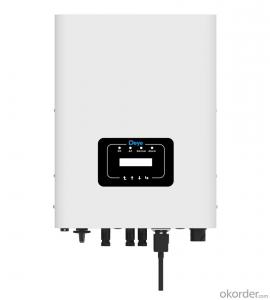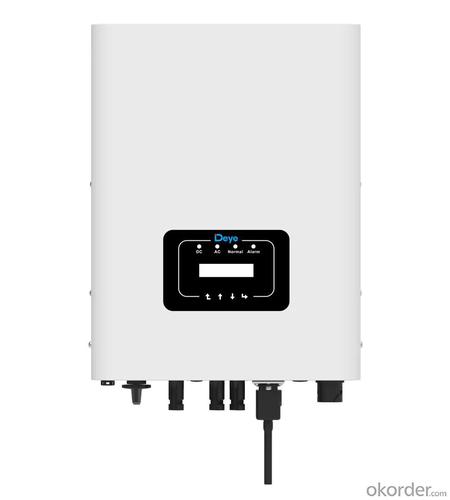SUN-15/17K-G03 15-17KW Three Phase 2 MPPT Higher yields
- Loading Port:
- Ningbo
- Payment Terms:
- TT OR LC
- Min Order Qty:
- 100 pc
- Supply Capability:
- 5000 pc/month
OKorder Service Pledge
OKorder Financial Service
You Might Also Like
Specification
2 MPP tracker, Max. efficiency up to 98.5%
Zero export application, VSG application
String intelligent monitoring (optional)
Wide output voltage range
Anti-PID function (Optional)
The series products adopt 2 MPP trackers design. Equipped with screw crimp terminal for DC and AC side, convenient installation and maintenance. With high detection accuracy, when the load power is less than 2%, the measurement accuracy is still high. In addition, it allows the system to be monitored and controlled remotely.
| Technical Data | ||||
| Model | SUN-15K-G05 | SUN-17K-G05 | ||
| Input Side | ||||
| Max. DC Input Power (kW) | 19.5 | 22.1 | ||
| Max. DC Input Voltage (V) | 1000 | |||
| Start-up DC Input Voltage (V) | 250 | |||
| MPPT Operating Range (V) | 200~850 | |||
| Max. DC Input Current (A) | 13+26 | |||
| Max. Short Circuit Current (A) | 19.5+39 | |||
| Number of MPPT / Strings per MPPT | 2/1+2 | |||
| Output Side | ||||
| Rated Output Power (kW) | 15 | 17 | ||
| Max. Active Power (kW) | 16.5 | 18.7 | ||
| Nominal Output Voltage / Range (V) | 3L/N/PE 380V/0.85Un-1.1Un, 400V/0.85Un-1.1Un | |||
| Rated Grid Frequency (Hz) | 50 / 60 (Optional) | |||
| Operating Phase | Three phase | |||
| Rated AC Grid Output Current (A) | 21.7 | 24.6 | ||
| Max. AC Output Current (A) | 23.9 | 27.1 | ||
| Output Power Factor | 0.8 leading to 0.8 lagging | |||
| Grid Current THD | <3% | |||
| DC Injection Current (mA) | <0.5% | |||
| Grid Frequency Range | 47~52 or 57~62 (Optional) | |||
| Efficiency | ||||
| Max. Efficiency | 98.5% | |||
| Euro Efficiency | 97.5% | |||
| MPPT Efficiency | >99% | |||
| Protection | ||||
| DC Reverse-Polarity Protection | Yes | |||
| AC Short Circuit Protection | Yes | |||
| AC Output Overcurrent Protection | Yes | |||
| Output Overvoltage Protection | Yes | |||
| Insulation Resistance Protection | Yes | |||
| Ground Fault Monitoring | Yes | |||
| Anti-islanding Protection | Yes | |||
| Temperature Protection | Yes | |||
| Integrated DC Switch | Yes | |||
| Remote software upload | Yes | |||
| Remote change of operating parameters | Yes | |||
| Surge protection | DC Type II / AC Type II | |||
| General Data | ||||
| Size (mm) | 333W×472H×202D | |||
| Weight (kg) | 15 | |||
| Topology | Transformerless | |||
| Internal Consumption | <1W (Night) | |||
| Running Temperature | -25~65℃, >45℃ derating | |||
| Ingress Protection | IP65 | |||
| Noise Emission (Typical) | <40 dB | |||
| Cooling Concept | Smart cooling | |||
| Max. Operating Altitude Without Derating | 2000m | |||
| Warranty | 5 years | |||
| Grid Connection Standard | CEI 0-21, VDE-AR-N 4105, NRS 097, IEC 62116, IEC 61727, G99, G98, VDE 0126-1-1, RD 1699, C10-11 | |||
| Operating Surroundings Humidity | 0-100% | |||
| Safety EMC / Standard | IEC/EN 61000-6-1/2/3/4, IEC/EN 62109-1, IEC/EN 62109-2 | |||
| Features | ||||
| DC Connection | MC-4 mateable | |||
| AC Connection | IP65 rated plug | |||
| Display | LCD1602 | |||
| Interface | RS485/RS232/Wifi/LAN | |||
- Q: How does a solar inverter communicate with other components of a solar power system?
- A solar inverter communicates with other components of a solar power system through various communication protocols such as wired interfaces like RS485 or Ethernet, and wireless technologies like Wi-Fi or Zigbee. These communication channels enable the inverter to exchange data and information with other components such as solar panels, batteries, and monitoring systems. This communication allows for real-time monitoring, control, and coordination of the system, optimizing its performance and ensuring efficient energy production and management.
- Q: What is the role of a power limiter in a solar inverter system?
- The primary function of a power limiter in a solar inverter system is to regulate the amount of power that is supplied to the grid from the solar panels. When the solar panels produce more power than necessary or permitted by the grid, the power limiter serves as a control mechanism to restrict the amount of power injected into the grid. This control mechanism ensures that the power output from the solar panels remains within the specified limits, preventing any overloading or destabilization of the grid. To achieve this, the power limiter continuously monitors the power output from the solar panels and adjusts it accordingly to meet the grid requirements. It achieves this by intelligently controlling the inverter, which converts the direct current (DC) generated by the solar panels into alternating current (AC) suitable for integration with the grid. By limiting the power fed into the grid, the power limiter plays a crucial role in maintaining the stability of the grid. It helps prevent voltage fluctuations, reduces the risk of power surges or blackouts, and ensures compliance with local regulations and grid codes pertaining to solar power generation. Furthermore, the power limiter can offer additional functionalities such as grid synchronization, anti-islanding protection, and remote monitoring. These additional features enhance the safety, reliability, and overall performance of the solar inverter system. In summary, the inclusion of a power limiter in a solar inverter system is essential for maintaining a balance between power generation and grid stability. It optimizes the use of solar energy and ensures the safe and efficient integration of solar power into the electrical grid.
- Q: Can a solar inverter be used with different grid voltages or frequencies?
- No, a solar inverter cannot be used with different grid voltages or frequencies. Solar inverters are designed to convert the DC power generated by solar panels into AC power that matches the specific voltage and frequency of the local electrical grid. Using a solar inverter with different grid voltages or frequencies can lead to compatibility issues and may result in inefficient or malfunctioning operation of the system.
- Q: How does a solar inverter handle voltage unbalance in the grid?
- A solar inverter handles voltage unbalance in the grid by employing its control algorithms to monitor and regulate the output voltage. When the solar inverter detects an unbalanced grid voltage, it adjusts the output voltage accordingly to maintain a balanced supply. This is typically achieved by injecting reactive power or adjusting the phase angle of the output voltage to synchronize it with the grid. By actively managing voltage unbalance, a solar inverter ensures stable and reliable power conversion in the presence of grid voltage fluctuations.
- Q: Can a solar inverter convert DC power to AC power?
- Yes, a solar inverter can convert DC power generated by solar panels into AC power that is suitable for use in homes and businesses.
- Q: What is the maximum DC voltage that a solar inverter can handle?
- The maximum DC voltage that a solar inverter can handle varies depending on the specific model and design. However, in general, most solar inverters can handle DC voltages up to 1000V or higher. It is important to consult the manufacturer's specifications to determine the maximum DC voltage capacity of a particular solar inverter.
- Q: Can a solar inverter be used in a solar-powered air conditioning system?
- Yes, a solar inverter can be used in a solar-powered air conditioning system. The solar inverter is responsible for converting the DC power generated by solar panels into usable AC power for appliances, including air conditioners. By utilizing a solar inverter, the solar-powered air conditioning system can effectively harness solar energy to cool spaces while minimizing reliance on traditional energy sources.
- Q: How does the temperature affect the performance of a solar inverter?
- The temperature affects the performance of a solar inverter by influencing its efficiency and power output. Higher temperatures can cause the inverter to operate less efficiently, resulting in a decrease in its overall performance. This is because the semiconductor components in the inverter may experience increased resistance, leading to more power losses and reduced conversion efficiency. Additionally, excessive heat can also lead to thermal stress and component degradation, potentially impacting the long-term reliability and lifespan of the inverter.
- Q: What is the role of a voltage regulation feature in a solar inverter?
- The role of a voltage regulation feature in a solar inverter is to ensure that the electricity generated by the solar panels is converted into a stable and consistent voltage suitable for use in homes or businesses. This feature helps to protect electrical appliances and equipment from voltage fluctuations and prevents any potential damage that could occur due to over or under voltage conditions.
- Q: Can a solar inverter be used in a floating solar system?
- Yes, a solar inverter can be used in a floating solar system. The purpose of a solar inverter is to convert the direct current (DC) generated by solar panels into alternating current (AC) that can be used to power electrical devices. In a floating solar system, the solar panels are mounted on floating platforms or structures on water bodies. The solar inverter is still required to convert the DC power generated by the panels into AC power that can be used by the electrical grid or connected devices.
Send your message to us
SUN-15/17K-G03 15-17KW Three Phase 2 MPPT Higher yields
- Loading Port:
- Ningbo
- Payment Terms:
- TT OR LC
- Min Order Qty:
- 100 pc
- Supply Capability:
- 5000 pc/month
OKorder Service Pledge
OKorder Financial Service
Similar products
Hot products
Hot Searches
Related keywords
























